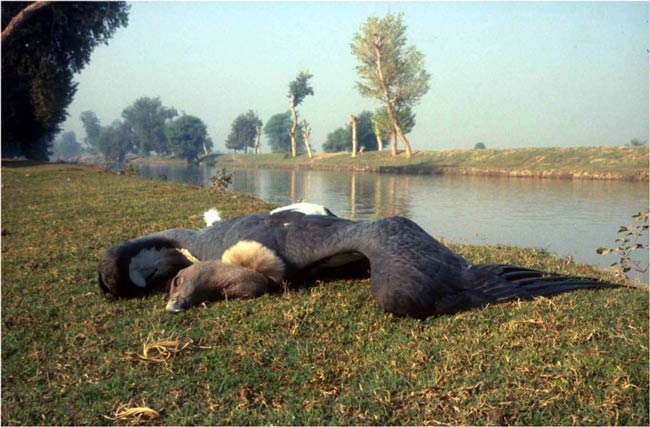Extinction Circles Giant Vultures

A shadow has fallen over endangered giant vultures whose captive populations are too small to save the species.
Captive breeding colonies currently lack the genetic diversity to ensure survival for oriental white-backed vultures (Gyps bengalensis) in the wild, where the birds are dropping dead from feeding on drug-tainted meat.
The vultures boast a seven-foot wingspan and thrived in South Asia until the mid-1990s, when people started using an anti-inflammatory drug called diclofenac to treat arthritis-like symptoms in livestock. Vultures that fed on the tainted carcasses of the animals died of kidney failure within a day or two.
"We know the problem, and we know the solution," said Jeff Johnson, a biologist who conducted the research at the University of Michigan in Ann Arbor and is now at the University of North Texas in Denton. "We just need to get diclofenac out of the environment and more birds into protection before it is too late."
Their fate shares similarities with that of the California condors in North America, which are dying from lead poisoning after feeding on animals wounded or killed by hunters.
A shrinking population means less genetic diversity that can help species adapt to changing environments and climates or disease outbreaks. The results could spell extinction for the giant vultures, despite the small captive breeding colonies in India and Pakistan.
Johnson and other researchers took genetic samples from old museum specimens of the giant vultures, and also collected recent feather and tissue samples from Pakistan's last remaining wild breeding colony. They then used computer simulations to determine that the number of vultures in captivity are not enough to maintain genetic diversity if wild populations go extinct – a likely case if people continue using diclofenac.
Sign up for the Live Science daily newsletter now
Get the world’s most fascinating discoveries delivered straight to your inbox.
The loss of the giant vultures means fewer of nature's garbage disposals to take care of uneaten livestock carcasses, which can become breeding grounds for bacteria and attract rabid feral dogs. Such birds also have cultural value for the ancient Parsi religion of South Asia, which places deceased people on "Towers of Silence" for vultures to consume the remains. The Hindu religion similarly reveres a vulture saint named Jatayu.
A conservation organization called the Peregrine Fund is working to try and save the giant vultures, but faces political, logistical and funding challenges in the vultures' home countries.
"One of my goals with this paper," Johnson said, "is to raise awareness of the problem and to increase political will in India and Pakistan to get this matter resolved."
The study is detailed in the August issue of the journal Biological Conservation.
- How Do Vultures Find Dead Stuff?
- 10 Species You Can Kiss Goodbye
- Images: Endangered and Threatened Wildlife










